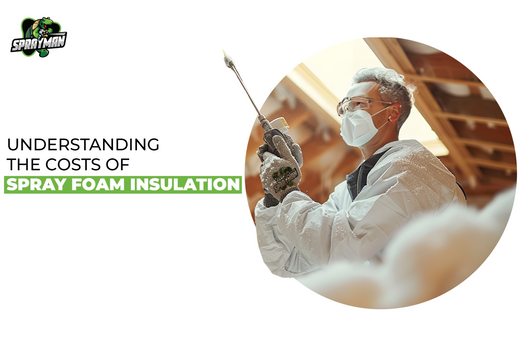Spray foam insulation for walls and ceilings is one of the most effective ways to improve energy efficiency, reduce heat loss, and create a more comfortable living environment. Because walls and ceilings make up a significant portion of your home’s thermal envelope, properly insulating these areas can noticeably lower heating and cooling demands, often reducing overall energy consumption by up to 30%. For homeowners seeking strong thermal performance, durability, and long-term savings, spray foam remains one of the most reliable insulation solutions available.
Both wall and ceiling insulation play an essential role in preventing drafts, stabilizing indoor temperatures, and minimizing air leakage. Whether you’re insulating a new home, upgrading existing insulation, or tackling a DIY project, understanding how spray foam works and how to apply it correctly helps ensure better results. Spray foam expands to seal gaps, strengthens structural components, resists moisture, and reduces noise.
In this guide, we explain everything you need to know about spray foam insulation for walls and ceilings, including when insulation is necessary, how to remove old materials, how to choose the right R-value, DIY installation techniques, cost expectations, and maintenance tips. With this information, you can make informed decisions and confidently approach any insulation project in your home.

Do You Need Wall and Ceiling Insulation?
Wall insulation and ceiling insulation significantly reduce energy consumption in a building. They are both necessary to improve the overall living condition of your home. Insulation helps to regulate the temperature of your living space all year. For instance, heat in your living area escapes easily through the ceilings without proper insulation. This means your HVAC system will work harder to regulate the temperature and keep your home warm.
Is Insulation Necessary for New Houses' Walls And Ceilings?
Insulation is necessary in new houses to create an air-sealed environment, prevent mold growth, and reduce drafts. Insulating the walls and ceilings in a new house improves energy efficiency and helps maintain a stable temperature.
Insulation seals air leaks caused by tiny spaces around electrical and plumbing penetrations in ceilings and walls. Spray foam insulation is ideal for new houses as it reduces noise, prevents moisture damage, and improves indoor air quality.
When Is It Necessary To Replace Your Old Insulation?
Old insulation should be replaced immediately if you begin experiencing high energy bills, drafts, and inconsistent temperatures in your home. High heating and cooling bills in homes are a result of air leaks. The best solution is to create an air-tight environment using spray foam insulation. Unlike fiberglass and cellulose, which allow air filtration, spray foam insulation seals your building effectively.
Which Type of Insulation Is Most Effective for Walls and Ceilings?
Spray foam is the best insulation for walls and ceilings. Spray foam is applied as a liquid and allowed to solidify, creating a thermal and moisture barrier. It offers a very high R-value with closed cell spray foam insulation. Spray foam insulation creates an airtight environment that helps reduce heat transfer and improve energy efficiency.
Spray foam wall insulation provides structural support for walls by hardening to form a rigid material. Spray foam insulation is applied to seal every tiny space in walls and ceilings, making it an excellent pest deterrent.
Benefits of Using Sprayman Spray Foam Wall and Ceiling Insulation for DIYers and Contractors
Sprayman spray foam insulation offers top-quality resistance against heat loss, noise, and moisture problems. Sprayman spray foam insulation is the best spray foam product on the market. For DIYers and contractors, it is affordable and has a high R-value of R5.66. The benefits of spray foam insulation using Sprayman Spray foam products include;
- Elimination of Lingering Odor: Insulation contractors face the problem of fixing lingering odor caused by spray foam after installation. Unlike other products, Sprayman spray foam insulation does not give off a bad odor after curing.
- Cost-effective: Sprayman spray foam is affordable; it is a cost-effective solution for both DIYers and contractors. For DIYers, using an affordable and easy-to-use spray foam product reduces the pain of errors during installation.
- Versatility: Sprayman spray foam offers strong bonding strength, making it suitable for all surfaces. It is compatible with different areas in a building, such as garages, ceilings, metal buildings, attics, and camper vans.
- Ecofriendly: Sprayman spray foam is eco-friendly which is a major concern for contractors. It is formulated using low GWP materials. Sprayman spray foam is recommended for contractors as it meets all local building codes and reduces carbon footprints in buildings.
- Customer Satisfaction: Contractors are on the job to achieve high-quality results and satisfy their clients. Using Sprayman spray foam is an assurance for a top-notch insulation job.
What Should You Know About Spray Foam Insulation for Walls and Ceilings?
Spray foam insulation is a versatile and effective solution for improving your building's energy efficiency and comfort. Whether you're considering it for different wall materials, ceilings, or interior and exterior applications, understanding its benefits and proper usage is crucial. Below, we explore key considerations and best practices for using spray foam insulation in various parts of your building's walls and ceilings.

Does the Wall Material Affect the Insulation Process?
There are different wall types with varying thermal properties, moisture permeability, and structural characteristics. Sprayman Spray foam Insulation is effective for all wall types by providing excellent thermal and water resistance. Spray foam is used for concrete wall insulation, to prevent thermal bridging and moisture damage.
Spray foam cavity wall insulation involves creating an additional wall cavity that is filled with insulation. Spray foam block walls improve thermal mass in concrete walls by reducing air leaks. This helps in improving the overall energy consumption in a building.
Should You Insulate Ceilings?
Insulating ceilings relates to the thermal envelope. In summary, a thermal envelope is the barrier that separates the conditioned indoor spaces from the unconditioned outdoor environment. If your attic is not insulated and you do not intend to use it as a living space, it is crucial to insulate the attic floor or the ceiling of the upper floor. Similarly, if the underside of your home is not insulated and you do not intend to use your basement as a living space, spray foam insulation basement ceiling is essential.
Insulation improves living conditions in other areas, such as garages, sheds, and outbuildings. You can save up to 30% on energy consumption by installing spray foam insulation on ceiling.
Should You Insulate Interior Walls?
Insulating interior walls is generally unnecessary if your home is properly insulated and has a well-established thermal envelope. However, there are two specific situations where it can be beneficial:
- Sound Insulation of Walls: To reduce noise transfer between rooms, insulating your interior walls is a practical solution.
- Insulation for Bathroom Walls: To prevent moisture from spreading to the walls surrounding your bathrooms, we recommend applying spray foam insulation around these areas.
Should You Apply Exterior Wall Insulation from Inside or Outside?
Applying wall insulation from the inside or outside has its pros and cons. Exterior spray foam wall insulation is highly efficient when done outside as it envelops the building completely. However, this method is expensive, can be messy if you trim the foam after it cures, and can disrupt the building’s facade. This option is often chosen for new homes during the construction process.
Spray in wall insulation is mostly done from inside the building, especially in existing homes. Unlike exterior insulation, interior wall insulation is easier and cheaper to install. A major disadvantage of adding insulation from the inside is that it reduces your living space by creating an extra layer of insulation.
What Is the Best Season To Start a Spray Foam Insulation Project?
The best time to install spray foam insulation is when there is moderate temperature during summer or spring. For optimal results, spray foam insulation should be installed in the temperature range of 60°F to 80°F (15°C to 27°C).
What Weather Conditions Are Ideal for Insulating Exterior Walls from Outside?
Exterior wall insulation should be carried out from outside during favorable weather conditions. The weather must not be rainy or windy. The ideal weather conditions for exterior wall insulation are moderate temperature (15°C to 27°C), mild winds, and dry weather.
How to Remove Drywall and Old Insulation Safely?
Removing drywall and old insulation is necessary before installing a new one. You can remove drywall and old insulation in 9 easy steps;
- Step 1: Wear protective equipment to protect your eyes, nose, and skin.
- Step 2: Turn off power to avoid hitting electrical lines.
- Step 3: Use a utility knife to cut along seams and around fixtures.
- Step 4: Remove the trim with a pry bar.
- Step 5: Remove screws or nails from studs.
- Step 6: Pull down the drywall sheets carefully.
- Step 7: Cut the old insulation using a knife or saw.
- Step 8: Use a paint scrapper to remove stubborn foam.
- Step 9: Dispose properly in waste bags and inspect for other issues.
What R-Value and Thickness Are Recommended for Wall and Ceiling Insulation?
Spray foam insulation R-value and thickness affect thermal resistance, and a high R-value means high thermal resistance. Understanding the correct R-value and thickness for your insulation is key to maximizing its thermal resistance. The insulation ratings for walls and ceilings depend on the type of spray foam used and wall studs used in insulation. Typically, the 2x6 wall insulation R-value is higher than the 2x4 wall insulation R-value. This is because the 2x6 wall insulation accommodates more insulation.
The recommended insulation for 2x4 walls is R13-R15 and R19-R21 for 2x6 wall insulation. For spray foam ceiling insulation, the recommended R-value is R30-R60, depending on your location. The type of spray foam used for insulation determines the thickness to be applied. A recommended thickness of 2-3 inches is ideal when using closed cell spray foam.
How Much Does Foam House Insulation Cost for Walls and Ceilings?
The average cost for spray foam wall insulation is $6,000. On the other hand, spray foam ceiling insulation costs $1,500 - $3,500. Spray foam insulation cost is dependent on several factors. The choice between hiring a professional and DIY affects the cost of spray foam insulation. Professional contractors charge as high as $4.5 per sq ft. Labor costs, the thickness of the foam, the type of spray foam used, the size of the project, and existing insulation also affect insulation costs.
The benefits of spray foam outweigh the cost of installation. It increases home resale value and saves energy costs. Homeowners can also break even with the cost of spray foam by receiving an insulation tax credit, employing DIY, and insulating during construction rather than after.
Step-By-Step Guide to DIY Spray Foam Insulation in Walls and Ceilings
DIY spray foam insulation will save the cost of getting a professional contractor. As with other processes, wall insulation foam gets better with more practice. Here is a step-by-step guide on how to carry out DIY insulation inside the walls and ceilings of a building:
- Step 1: Prepare the wall or ceiling by removing debris, moisture, and dirt. Ensure the area is well-ventilated. Turn off electrical components. Measure the area to be insulated to determine the amount of spray foam required for the job.
- Step 2: Wear personal protective equipment to protect the eyes, nose, and skin.
-
Step 3: Get spray foam insulation kits. Mix the spray foam properly before application. To apply spray foam, use a spray gun and apply the foam 20 - 30 cm away from the walls or ceiling.
Apply the foam from the bottom and work your way up for spray foam wall insulation. It is important to start applying from the corners before working your way to the other areas.
For spray foam ceiling insulation, apply the foam in small sections. Apply the foam evenly and provide an allowance for expansion. To achieve thick insulation, apply spray foam in layers, and ensure consistency in thickness. - Step 4: Allow foam insulation to cure for at least 24 hours.
-
Step 5: After curing, trim excess foam using a utility knife. Insect the job and reapply the insulation on missed spots.
What Maintenance Is Required for Your Spray Foam Insulation?
Regular maintenance is important to maintain the effectiveness of spray foam insulation. Here are 5 important maintenance that are required for your spray foam insulation;
- Inspect the insulation regularly for signs of damage, moisture accumulation, or wear.
- Use sealants to close any visible cracks or gaps.
- Paint over your insulation if it is exposed to UV radiation.
- Ensure adequate ventilation in your home at all times.
- Hire a professional contractor at least once a year for routine audit and maintenance.

What Are the Environmental and Health Impacts of Spray Foam Insulation?
Spray Polyurethane Foam SPF is made by mixing two different chemical compounds: isocyanates and polyol resins. Naturally, these compounds tend to have the risk of releasing harmful volatile organic compounds (VOCs). Improper installation of spray foam leads to the release of these harmful VOCs. Prolonged exposure to Isoyancates compound irritates the eyes, nose, and skin. It can lead to other health challenges, such as asthma, lung irritation, and respiratory inflammation.
As a homeowner, it is important to inquire about the global warming potential (GWP) of your spray foam product. A low GWP spray foam product is environmentally friendly with no negative health impacts. Therefore, always opt for Sprayman Spray Foam Sound and Thermal Insulation with low GWP.
FAQs
Which Type of Spray Foam Insulation Is the Best for Your Walls and Ceilings?
Closed-cell is preferred over open-cell spray foam insulation because it offers higher thermal and water resistance. Open-cell spray foam is cheaper and provides better sound insulation. Closed-cell vs. open-cell debate is important before you begin spray foam wall insulation.
How Much Does Spray Foam Insulation Cost?
Spray foam insulation costs vary depending on the type of foam, project size, and whether you choose DIY or professional installation. For a detailed cost breakdown, refer to our Comprehensive Spray Foam Insulation Cost Guide.
How To Insulate Exterior Walls?
To learn how to insulate your exterior walls effectively, check out our detailed step-by-step guide on our blog. Using spray foam insulation, you can easily enhance your home's thermal performance. Follow our comprehensive instructions to ensure a thorough and efficient insulation process.
Is It Possible To Use Spray Foam for Ceiling Insulation?
Yes, it is. Spray foam insulation is highly effective for ceiling insulation. Spray foam ceiling insulation is easily sprayed into every area of your ceiling. It provides the perfect protection against heat loss and moisture accumulation in ceilings.
How To Add Insulation To Walls?
Several insulating materials can be used for wall insulation, including fiberglass, cellulose, rigid boards, and spray foam insulation. The first step in adding insulation is to ensure the wall is dry and free from dirt. Next, install the insulating material and cover it with drywall. It is important to remove old insulation before installing new insulation, as adding spray foam insulation to existing insulation reduces its efficacy.
Can You Spray Foam Insulation into Existing Walls?
Yes, spray foam insulation is commonly used for insulating existing walls. If you want to insulate your existing walls without removing drywall or other wall materials, professional contractors create holes in the walls and inject foam insulation into the wall cavity.
How to Insulate Walls Without Removing the Drywall
It is possible to insulate walls without removing drywall by injecting or blowing in the insulation. Injection foam insulation is the best option for this process as it is used to fill closed cavities. With injection foam insulation, your wall can be insulated while keeping drywall intact.
Is Injection Foam Insulation Worth It?
Injection foam insulation is a delicate process that requires the services of professional contractors. Without proper installation, foam injection insulation creates gaps that may lead to air leaks. Hiring an experienced contractor makes it expensive to install when compared to DIY spray foam insulation. Injection foam insulation offers a lower R-value than other common types of insulation. We recommend spray foam insulation if your drywall or other wall materials are old and need to be renewed.
Can You Use Spray Foam in a Cavity Wall?
Absolutely! Spray foam insulation is used for cavity wall insulation. Spray foam effectively fills the cavity wall, creating an airtight environment in the building.
Should Electrical Outlets Be Insulated?
Yes, this is because electrical outlets can become entry points for air infiltration in a building. Electrical wall outlet insulation is an effective solution for eliminating drafts in buildings.
Can Spray Foam Insulation Get Wet?
Spray foam insulation can get wet but its reaction to moisture is based on the type of foam installed. Closed-cell offers excellent resistance to moisture without getting damaged. On the other hand, open-cell is light and absorbs water easily.




Leave a comment
This site is protected by hCaptcha and the hCaptcha Privacy Policy and Terms of Service apply.